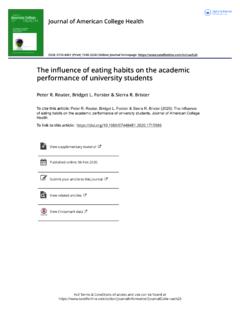Transcription of Students’ Readiness for E-learning: A Case Study of ...
1 Journal of Learning in Higher Education59 INTRODUCTION Distance education is to promote self Study or independent Study among distance learners in the absence of regular face-to-face to face teach-ing (Simpson, 2001). The rapidly changing global economies enhance people and organizations to keep up with the rapid changes that define the Internet world. E-learning is a new education concept by using the Internet technology, it de-liveries the digital content, provides a learner-ori-ent environment for the teachers and students . To achieve this, every Distance Learning Insti-tutions extend support to its learner, All these activities beyond the production and delivery of course material assist in the progress of students in term of learning, interacting and effective communication.
2 As above mentioned, student support services provided by Distance Learn-ing Institutions are still based on factors of the learning process such as attention, motivation, emotional aspects, and students Readiness to dif-ferent e-learning strategies. Kanchana Chokrien-sukchai (2005)studied A Feasibility Study of Using E-Learning for Post-Graduate Studies. It found that e- Learning was saving time and money in traveling to school. The students were lack of technology skills and english. They had negative attitudes towards e- Learning.
3 The les-sons were not Thammathirat Open university (STOU) was established in 1978. The univer-sity employs distance learning system that makes quality higher education accessible to all who wish to further their studies, especially adult learner. The main teaching materials have tra-ditionally been print-based packages that are mailed to students . Presently, the university has begun offering two instructional approaches: one centered on printed core materials and the other on computer-based Study materials. In 2013, The university will be provided the teach-ing through e-Learning for graduate students .
4 The university prepares the Readiness of instruc- students Readiness for E-learning: A Case Study of Sukhothai Thammathirat Open university ,ThailandSuttiwan TuntirojanawongAssociate Professor School of Educational Studies Sukhothai Thammathirat Open university ThailandABSTRACTThe process of e-learning is the operations that involve humans, computers, the Internet, and in-structional material, and that produces the outputs to learners and the organization. The purposes of this research were (1) to Study students Readiness for e-learning of graduate students major-ing in educational administration, School of Educational Studies,Sukhothai Thammathirat Open university ; (2) to compare students Readiness for e-learning of graduate students majoring in educational administration, as classified by gender, age, technology experience.
5 The research sample consisted of 162 graduate students majoring in educational administration, obtained by simple random sampling. The research instrument was a rating scale questionnaire with .86 level of statistics used for data analysis were percentage, mean, standard deviation, t-test, and ANOVA. The research findings showed that (1) the over all of students Readiness for e-learning of graduate students majoring in educational administration were ready status and category that Technology Access had the highest mean and Study skills,Technology skills had the lowest mean.
6 ; (2) There was no significant difference of the students Readiness for e-learning of graduate students majoring in educational administration as classified by gender,age groups, and technology is recommend that the university should improve graduate students Readiness in Study skills, and Technology Tuntirojanawong60 Spring 2013 (Volume 9 Issue 1)tor for e-Learning by short time training. The efficiency of e-learning built upon a unique rela-tionship between learners and instructors. Most of graduate students in Educational Aaministra-tion Department are working people who have an age range going from 30 to 60.
7 They will learn to use Technology with the requirements of be-ing a distance masteral student. There is a critical question of how to motivate them to fully be ab-sorbed in the online learning is neces-sary to understand graduate students Readiness for transition an adult learner into e-learning . Strategies need to be developed based on gradu-ate students Study aimed to Study students Readiness for e-learning and compare the personnel s opinions towards students Readiness for e-learning ac-cording of gender, age, technology experience of graduate students who attended in Educational Administration, School of Educational Stud-ies, Sukhothai Thammathirat Open university .
8 LITERATURE REVIEW E-learningE-learning can be defined from different per-spectives. There are specialists who consider that e-learning means any teaching process which integrates any form of technology, but there are others who claim that e-learning represents a teaching solution for distance education, facili-tated by the massive penetration of internet as a form of communication. E-learning is rapidly growing as an acceptable way of education. Re-markable progress has been made in e-learning in couple of last decades (Raymond,2000).Nichols (2003) defines the concept as the use of various technological tools that are either Web-based, Web-distributed or Web-capable for the purposes of education.
9 Hoppe and Breitner (2003) describe e-learning as a learning which is supported and/or made possible by the use of modern ICT and computers. Newman (2008) defines e-learning as usage modern ICT to de-liver learning and training of the most popular forms of e-learning is online learning via the Web. Research suggests that to succeed in online learning, learners must be able to motivate themselves, manage their time wisely, take responsibility for their own learning, and participate in the give-and-take of electronic discussions (Collett, 2000, cited in Porter and O Connor, 2001; Rovai, 2003; Smith, Murphy, &Mahoney, 2003).
10 Further-more, they must take initiative, be resourceful, demonstrate persistence, and believe in their ability to organize and carry out the actions needed to engage in learning (Derrick, 2003). Online learners need to be able to solve problems and to evaluate and monitor their own nature of instruction also plays a big role in successful online learning, and online instruc-tors vary in their ability to help students succeed. Johnson and Aragon (2003) identify the follow-ing seven general pedagogical principles as criti-cal for success in online learning environments: (1) Address individual differences.










